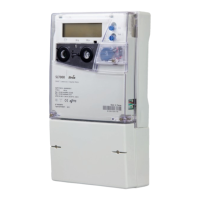6.9.3.3. Summation registers
The meter can be configured with up to four summation energy registers that algebraically sum the contents of
up to five energy rate registers (internal or external) recording the same type of energy.
The illustration below shows two (out of four) summation paths with five inputs (A,B,C,D and E) each.
The result of the summation process is only stored in the register if it is a positive value. Negative or null results
are equal to zero and not stored.
The summation calculation takes place once-a-second, so any pulse input signal used for summation must have
a frequency higher than 1Hz to ensure accuracy.
6.9.4. Demand registering
The contract between the customer and the utility company may specify certain energy demand limitations or
threshold parameters. Exceeding those stated limits could result in penalties being issued.
Meter-based demand registering is a convenient way for both the customer and the utility to monitor energy
consumption.
All the measured energy quantities (page 35) recorded by the meter are available for demand registering, such
as:
• Per phase
• Aggregate
• Summation

